
















|
Denmark’s Prince Henrik: A Man of Many Parts
by Peter Cummins
No, Prince Henrik, the Danish Royal Consort, bears no comparison to Shakespeare’s Danish Prince, immortalized in “Hamlet”. He is, in fact, quite the
opposite: decisive, circumspect and multi-talented.
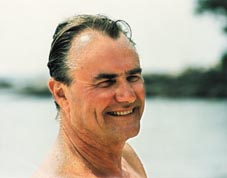 Prince Henrik: a portrait. Photo by
Peter Cummins Prince Henrik: a portrait. Photo by
Peter Cummins
When Queen Margrethe II and her Royal Consort Prince Henrik visited Thailand earlier this month, it represented 20 years, almost to the day, since the Danish
Royal Couple last visited the Kingdom in 1981, stopping over en route to China. Accompanied this time by HRH Crown Prince Frederik, the Danish Royal family were here as guests
of our own Royal Family and were met at the airport by the King and Queen themselves.
No doubt, one of the highlights of the visit was enjoyed immensely by King Bhumibol, for it featured a performance by a group of Denmark’s foremost jazz
musicians during a banquet hosted by Queen Margrethe at the Oriental Hotel.
Jan Olav Aamlid: Dane for a day
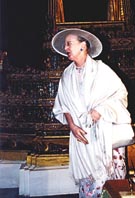 Queen Margrethe II of Denmark:
portrait of a Monarch. Photo by Jan Olav Aamlid Queen Margrethe II of Denmark:
portrait of a Monarch. Photo by Jan Olav Aamlid
Pattaya Mail’s own Jan Olav Aamlid switched his Norwegian cap to don a Danish one - albeit only for a day – when he went to
Bangkok to take part in the exhibition at the National Museum entitled Thai-Danish Relations Through Four Centuries which was opened by the Danish Queen. While there,
Jan, who was exhibiting at the show, met HRH Maha Chakri Sirindhorn, the Danish Royal Family, the Ambassador and many other members of the extensive Danish community in
Thailand – including many of our Pattaya resident Danes.
Queen Margrethe had previously met the Thai King and Queen during their visit to Denmark in 1960, when she was a teenage Princess. After her parents, King
Frederik IX and Queen Ingrid returned the honour by visiting Thailand in 1962, the then Princess sailed to the Kingdom in 1963, aboard the vessel “Selandia”, a ship of the
East Asiatic Company - which, incidentally is located alongside the Oriental Hotel. So this visit covered some familiar territory.
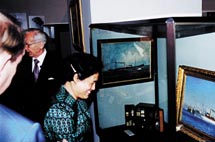 HRH Princess Maha Chakri Sirindhorn
admires one of Jan Olav’s exhibits at the National Museum. Photo by Jan Olav Aamlid HRH Princess Maha Chakri Sirindhorn
admires one of Jan Olav’s exhibits at the National Museum. Photo by Jan Olav Aamlid
Actually Thai-Danish relations go back, as the exhibit noted, for four centuries. The Danish presence intensified towards the end of the Nineteenth Century
and it was King Chulalongkorn who, intent on modernizing the Kingdom, brought in legions of Danish engineers and other skilled personnel. Being true Vikings, these wild fellows
brought a fleet of dinghies with them and started racing at Pak Nam. From all accounts, these were riotous, rollicking outings, as one would expect from any bunch of
sailors – anywhere!
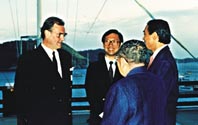 Prince Henrik (L) with Phuket
King’s Cup Regatta principals (1989). Photo by Peter Cummins Prince Henrik (L) with Phuket
King’s Cup Regatta principals (1989). Photo by Peter Cummins
Actually, the activities of this group have been the source of many stories that this Pattaya Mail scribe has produced about the origins of sailing
and yacht-racing in the Kingdom in which the early Danes are writ large, so to speak.
As it happened, I had the good fortune to have sailed with Prince Henrik some years ago at successive Phuket King’s Cup Regattas. I interviewed him later
and, in view of his recent visit, the Pattaya Mail decided to run extracts of the story, which has been reproduced in Danish, German, French and, of
course, in English in the Bangkok Post (7 January, 1990).
The Sailor Prince
“No, not like that,” he said so very politely. He leaned forward, carefully removed the ice from a glass set before him and them motioned to the waiter
to pour in precisely three fingers of Pastis. Then water was added and the drink turned to its usual milky consistency, somewhat the colour of grapefruit juice. He
selected one piece of ice which he added himself and, la voila, there was the traditional anisette-flavoured aperitif favoured by the inhabitants of southern France.
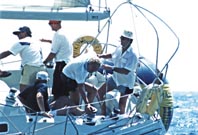 The Sailing Prince drives Viking
Virtue to windward. Photo by Peter Cummins The Sailing Prince drives Viking
Virtue to windward. Photo by Peter Cummins
Now the Prince Consort of Denmark was ready for our interview. His somewhat casual demeanour, framed by a handsome, almost boyish face, smiling eyes and a
ready wit, immediately puts people at ease. We could easily have been in Nice, the city that is twinned with Phuket, not only because of the fragrance of the Pastis but
also the ambience, the light and the flora matched.
The beautiful Nai Harn Bay below could well have been the Mediterranean. We were sitting in the corner of the Regatta Club, under a wall of memorabilia
dedicated to His Majesty the King of Thailand, as a sailor. It was the Phuket Yacht Club Hotel and Beach Resort (now the Royal Meridien Yacht Club Hotel) and Prince Henrik had
just come off the helm of the sleek charter Swan 57 sloop, Cowrie Dancer (re-named the Viking Virtue - for obvious reasons – for the duration of each regatta in
which he participated), to finish fourth in the just-ended Third Phuket King’s Cup Regatta. In fact, for the interview, he was still dressed in sailing gear.
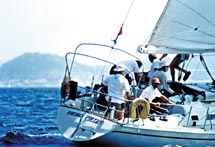 At the helm: a temporary release
from regal obligations. Photo by Peter Cummins At the helm: a temporary release
from regal obligations. Photo by Peter Cummins
The Prince had come to Thailand from Hong Kong where he had just led the Royal Danish Yacht Club to an inter-port victory over Royal Hong Kong and the Royal
Yacht Squadron from Cowes, Isle of Wight. Competing in Dragons (appropriate for Hong Kong waters, I thought), an Olympic class one-design, the Prince over an eight-race series,
wrested the coveted Dragon Silver Cup and incidentally, his own Prince Henrik trophy, from the Hong Kong titleholders.
“What an incredible difference between sailing here and in Hong Kong,” he said, sipping his Pernod. “After sailing off the China Coast, Phuket gives
the feeling of a limitless horizon, free of the enormous amount of shipping and the endless procession of harbour traffic which make sailing quite hazardous in Hong Kong.”
The very ambience is different; “the warm waters of the Indian Ocean, the remarkable iridescence of the Andaman Sea, the temperature, and the moderate, steady northeasterly
at this time of the year, combine to make Phuket a most desirable venue for a yacht race – or anything else, for that matter,” he enthused.
“In fact,” said the Prince, warming to what was obviously a favourite topic, “it is hard to find a better location than Phuket – anywhere in the
world. For countless years, northern Europeans have flocked to the Mediterranean, the Aegean and other waterways, for the comparative luxury of warm-water sailing. Now, of
course, most of these areas are overcrowded and polluted.”
Furthermore, in terms of sailing, he added, “the Mediterranean is a place of extremes – too little wind or too much.” He gazed out over Nai Harn Bay,
where the Viking Virtue was gently tugging at her anchor, riding easily in the 12-knot offshore northeasterly which rippled across the bay. “Yes, I see what you mean,
Your Highness,” I said.
Naturally, the conversation turned towards His Majesty the King, and the difficulties of dedicating time to the demands of competitive yacht racing,
pre-empted by the pressure of royal duties. “Such visits as Hong Kong and Phuket for yacht racing were all too few,” said the Prince.
An obvious problem in sailing, as against other sports, is the public exposure. For example, royalty can play golf, tennis, go horseback riding – even
sea-bathing – in privacy. But in yacht racing, it is that big open arena – the sea – where public exposure is unavoidable. This, is itself, places certain inhibitions, if
not outright restrictions, on yacht racing by royal sailors.
Competition
Nevertheless, as with our own King, Prince Henrik, Philip, the British Royal Consort, King Constantine of Greece, and Juan Carlos, the Spanish King, are just
a few of the royal families who have not only sailed but have also excelled in international competitions. In fact, Thailand’s “National Sports Day” is held each year to
commemorate the day in December 1967 when His Majesty won a gold medal sailing in the Fourth South East Asia Peninsular Games at Pattaya.
 Gracing the opening of the Third
Regatta (L to R): Former PM Prem, Regatta president Peter Ole Herning, Regatta founder Mom Tri Devakul, Prince Henrik and Regatta manager Khun Pornchai. Photo by Peter Cummins Gracing the opening of the Third
Regatta (L to R): Former PM Prem, Regatta president Peter Ole Herning, Regatta founder Mom Tri Devakul, Prince Henrik and Regatta manager Khun Pornchai. Photo by Peter Cummins
Prince Philip has excelled in Dragon class racing and Crown Prince Harald of Norway is an international champion. “Prince Henrik,” his aide, Jakob
Johannsen confided to me, “could well be an Olympic gold medallist – if he could only dedicate the time to practice.” He placed third in the 1988 European Dragon
Championships and that was in a fleet of some of the world’s best helmsmen with no time for warm-ups. Prince Henrik’s affinity for Asia is very easy to understand. He spent
the first five years of his life in Vietnam which was then part of French Indo-China. Born Henri de Monpezat on 11 June, 1934, in Talence, Gironde, France (now I could
understand his penchant for pastis), the Prince became proficient in both Vietnamese and Chinese, eventually pursing higher studies at the Sorbonne in these languages.
Similarities
There are many similarities, besides sailing, that Prince Henrik has to our own King. He constantly seeks excellence in all of his numerous pursuits. He is a
talented painter and also likes sculpting and drawing. He is a first-class pianist and organist and has composed music and written and published his own poems.
When he married the then Crown Princess Margrethe in 1967 and took up residence at the royal household, Amalienborg, in Copenhagen, one of his first “honours”,
as he put it, was as pianist with the orchestra of the Danish Royal Theatre. “It was a Beethoven piano concerto,” he recalled. “I remember it well,” he smiled broadly,
“for the conductor standing at the podium was my father-in-law, King Frederick IX.”
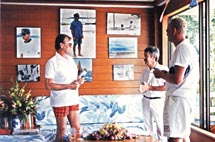 Prince Henrik greets the scribe
and his aide, Jakob Johannsen. Photo by Annie Prince Henrik greets the scribe
and his aide, Jakob Johannsen. Photo by Annie
This was not his first time to Thailand and, as he said, “it certainly won’t be my last.” On an earlier visit, Prince Henrik went to Hua Hin and sailed
at His Majesty’s own Royal Chitrlada Yacht Squadron in the OK dinghy which was, in fact, designed by a Dane, Khud Olsen. The Prince had very warm memories and he and Queen
Margrethe are close friends of Thailand’s King and Queen.
Prince Henrik is rather philosophical about himself as Prince Consort. His difficulties were more marked than, say, Prince Philip’s, for he had to change
not only a complete lifestyle, but also his nationality, religion, language and culture. But his great sense of humour has always prevailed. “A Prince Consort needs the
sensitivity of a seismograph, but the hide of a rhinoceros; he is, virtually, a tightrope walker,” he added, with a knowing smile.
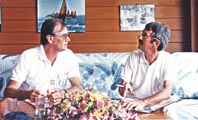 The scribe interviews the Prince.
Photo by Annie The scribe interviews the Prince.
Photo by Annie
His humour, he knows, has helped him through some difficult situations. “It was not easy for a Latin type to become a genuine Dane at short notice,” he
said with a laugh. He admires the way the Danish people have respected his efforts to perform his duties as the Prince Consort, yet be able to retain his own identity. Or, as
he describes himself, “the contents are the same, but the label has been changed.” He considers himself a Dane and can be moved by such nationalistic trappings as the
Danish flag flying. But, when he talks of himself, he uses the French appellation “Henri’ and not the Danish “Henrik.”
Following other royal prerogatives, Prince Henrik is President of the Danish National Organisation for the World Wildlife Fund. He has also been a long-time
Commissioner with the Danish Red Cross and his humanitarianism brings him into regular contact with the United Nations High Commissioner for Refugees.
A sporting life
He is an excellent tennis player and skier and spends enjoyable hours riding “Santo”, his favourite horse. He also holds a civil licence and flies his
own plane to France to spend time at the family vineyards at Le Cayrou, southern France.
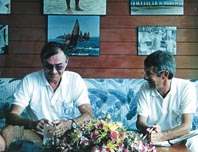 The Pattaya Mail scribe
interviews the Prince. Photo by Annie The Pattaya Mail scribe
interviews the Prince. Photo by Annie
The long summer days in Denmark find the Prince at the helm of “Triton”, the yacht which was a wedding gift to the royal couple from the Royal Danish
Yacht Club. His prowess at local regattas is legendary.
The close contact with the sea that he feels through sailing is his antidote to the stress of modern life. It is a communion with nature that he relishes.
Will he come back for another Phuket King’s Cup Regatta? I asked him. “As often as possible,” he replied quickly. “When he can combine the competitiveness of such a
regatta with the sheer joy of sailing in these beautiful warm waters, Prince Henri will come to Thailand,” he confirmed, reverting to the third person – and, of course, his
French name. I think Henrik, his after ego, would doubtless, approve.
PILC donates 1/2 million baht to Redemptorist Street Kids Home
In a small ceremony, Julie Garrat, president of the Pattaya International Ladies Club donated 500,000 baht to Father Raymond Brennan. The donation, held at
the Redemptorist Street Kids Home in Banglamung is the result of the activities held over the previous year.
 Father Raymond Brennan cheerfully
and with much gratitude accepts a 500,000 baht donation from Julie Garrat, president of the Pattaya International Ladies Club on behalf of the PILC. Father Raymond Brennan cheerfully
and with much gratitude accepts a 500,000 baht donation from Julie Garrat, president of the Pattaya International Ladies Club on behalf of the PILC.
Father Brennan accepted the donation saying that it would be the down payment for the construction of the Girls dormitory. The girls’ home, which is
currently on Pattaya Central Road, will be moved out to the Banglamung site once the 5.3 million baht project is completed. It will house up 100 girls and include a library,
music room, office and meeting and educational facilities. Father Ray also said that once half of the project cost is raised they can commence construction of the building.
After the ceremony the Pattaya International Ladies Club members also donated food items for the children, which brought out many smiling faces.
Pattaya Gay Festival
The Pattaya Gay Festival launch party held on Valentines Day, February 14, was a great success. The launch party was held at Boyz Boyz Boyz club and raised
130,000 baht for the PGF charities. 100,000 baht was raised through entrance and raffle ticket sales and a collection box for donations. An additional 30,000 baht was donated
by Boyz Boyz Boyz. launch party was held at Boyz Boyz Boyz club and raised
130,000 baht for the PGF charities. 100,000 baht was raised through entrance and raffle ticket sales and a collection box for donations. An additional 30,000 baht was donated
by Boyz Boyz Boyz.
The winning logo for the Pattaya
Gay Festival
The top prizes for the raffle were a sapphire ring valued at 44,000 baht, donated by Honest Gems, and a color TV and VCD player donated by Ambiance Hotel.
The next event will be a charity Dinner at Bruno’s Restaurant on Wednesday, March 7, at 8.30 p.m. The admission is 750 baht.
This band is Better
Last weekend, the customers in Shenanigans Irish Pub were cheering wildly and dancing feverishly to John, Paul, George and Ringo. So? We’ve all danced to
the Beatles’ music - there’s plenty of CD’s out there. The difference at Shenanigans was the music was live - presented by a Beatles cover group known as the Better
Band.
 The Better Band wowed the crowd at
Shenanigans last week The Better Band wowed the crowd at
Shenanigans last week
The lads from Lumpini, via Liverpool, presented a sensational tribute to the Beatles with a raging repertoire of the Fab 4’s numbers. Close your eyes and
you would swear it was the originals - Liverpudlian accents and all. Complete with the period Beatles’ suits, the Better Band was not just better - they were the best!
If you missed them and want to see what they were like, watch the Pattaya Mail Channel’s Nite Beat show this weekend. Mott the Dog even gave them six
stars out of five. However, the best news is that they are coming back to Shenanigans on Thursday 22nd of March. Circle the date in your diary. You won’t regret it!
PSC Sports Club supports Children’s Day
Softball chairman John McAllen presented on behalf of Pattaya Sports Club, five thousand baht worth of school stationary consisting of: six hundred lined
school books, one thousand five hundred pens, three hundred pencils with erasers, and forty packs of rulers.
 Softball chairman John McAllen, on
behalf of Pattaya Sports Club, presented school supplies to Pattaya School No. 7. Softball chairman John McAllen, on
behalf of Pattaya Sports Club, presented school supplies to Pattaya School No. 7.
There was plenty of food and drink donated for the day, dance shows on stage, and in the afternoon a sports day, as well as lots of team games and
individual events, and prizes for the winners. The event was held at School No. 7. Once again PSC supports local charities and helps local schools in promoting sports.
Khomsan Seesam named Diana Group Administrative Employee of the Year
Diana Group managing director Sopin Thappajug and general manager Withun Wongsawat awarded Khomsan Seesam as Diana Group “Administrative Employee of the
Year 2000”.
 Khomsan was selected for sacrifices made on the job, his personal endurance, honesty,
and persevering when facing difficult situations. Khomsan was selected for sacrifices made on the job, his personal endurance, honesty,
and persevering when facing difficult situations.
A graduate in hotel management from the Pattaya Business Administration College, Khomsan now holds the position as resident manager at the Diana Inn and is
in his final year of study for a doctorate degree in general management from the Rachabhad Institute.
Ranjith’s guide to matching food and wine
 By Ranjith Chandrasiri By Ranjith Chandrasiri
Matching wine with food is like gambling: There are winners and losers, and there’s always somebody who’s willing to sell you a technique guaranteed to
beat the odds.
The first thing to remember about matching food and wine is to forget the rules. Forget about complicated techniques for selecting the right wine to
enhance the food on the table. This is not rocket science. It’s common sense. Follow your instincts.
The oldest, safest system, of course, is “white wine with fish, red wine with meat.” But while this approach will minimize your losses, it also limits
the chances of your having one of those exciting moments when an unlikely combination hits the jackpot and the interlocking flavours of wine and food create a faultless and
unforgettable taste experience.
Choose a wine that you want to drink by itself. Despite all the hoopla about matching wine and food, you will probably drink most of the wine without the
benefit of food - either before the food is served or after you’ve finished your meal. Therefore, you will not go too far wrong if you make sure the food is good and the
wine is, too. Even if the match is not perfect, you will still enjoy what you’re drinking.
Some of today’s food-and-wine pontificators suggest that mediocre wines can be improved by serving them with the right food. The flaw in that reasoning
is the scenario described above. If the match does not quite work as well as you hoped, you’re stuck with a mediocre wine. First pick a good decent wine. Try to avoid those
cheap and nasty wines with fancy labels, which apparently had been imported to Thailand in the last 2-3 years after the Baht devaluation. I have tasted many of those and I am
sorry to say that most of them are not even good enough for cooking. The good news is, that I am noticing these days the availability of some good quality wines at reasonable
prices in good wine shops and supermarkets.
New systems are more complicated. This may be because both food and wine are more complex today than ever before. A single dish might combine ingredients
from Asia, France and the American Southwest, for example, in a potent blend of hot, sweet and herbal flavours. And while the options for red wine might once have ranged from
Bordeaux to Burgundy, wine stores now stock Cabernets and Pinot Noirs from a dozen different countries in just as many styles. Unfortunately, one result of this greater
number of variables is that the chances of making an ill-fitting match - losing your gamble - are exponentially increased.
So if you consult contemporary textbooks on matching wine and food, you’ll find less strictness and more nuance, fewer universal rules and a profusion of
situation-specific principles. The most complicated system I’ve seen breaks both food and wine into three elements - components, flavours and textures - each with multiple
subdivisions, and then advises that you base your matches either on similarities or on contrasts in each element.
My system is less comprehensive, but it’s a lot easier to use. It’s based on a theme that runs through almost all the current techniques. The key is to
analyse a single basic element in both food and wine; I call it “weight,” or body.
In a good match, the wine should have roughly the same weight as the food. If the wine is a little heavier, that’s okay, too. Delicate foods show best
with lighter wines; heartier ones need heavier (or richer) wines for balance. You are probably already following this principle to a large extent. For example, when you serve
oysters with Muscadet, or lamb with Cabernet Sauvignon, you’re matching wine and food weights to perfection. But while these two pairings have the guarantee of long
tradition behind them, they don’t exhaust the possibilities. Chablis, Sancerre, Pinot Grigio and Orvieto are all light-bodied whites that make fine complements to oysters.
Barbera, Zinfandel and Shiraz have weights similar to Cab, and would taste just fine with that lamb.
Unfortunately, the labels on bottles of wine aren’t required to list the wine’s weight along with its alcohol level. And there are no foolproof
indicators. Merlot, for example, may be full-bodied when it comes from Pomerol, middle-bodied from Chile and light-bodied from northeast Italy. Chardonnay fermented in
stainless steel is usually lighter in weight than Chardonnay fermented in new oak barrels. And the same red Burgundy will be lighter in a diluted vintage like 1987, heavier
in a ripe one like 1990.
This is why we write tasting notes: to situate a specific wine on a more general continuum. Sommeliers and salespeople can also be helpful in deciphering
the weight of a given wine. But if you don’t have personal experience or expert guidance to draw on, don’t worry - there are some simplifications that can be helpful. I
have divided basic wine types into lighter and heavier categories according to overall type, whether varietal or region of origin. I have done the same with basic foodstuffs.
The goal is to increase the odds of at least breaking even when I am looking to put dinner on the table.
(Ranjith will continue next week with some specific examples of wines for you to try next time you are wining and dining.)
Antiques, Are They Genuine?
by Apichart Panyadee
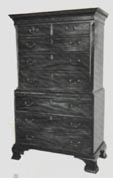 Pastiches Pastiches
A pastiche can be more difficult to identify than an outright fake. It is a piece that started out life as one kind of furniture and was altered to make
quite another. It will retain a substantial proportion of its original bodywork, perhaps 25 percent or a little more. And so old timbers will be visible and proportions are
likely to be convincing. A cursory inspection may well indicate that the item is genuine. However, you must know that such items have been prone to alteration. You must make
a thorough examination.
The chest of drawers of modest merit turned into the highly desirable kneehole desk or dressing table is a typical example of profitable and deceptive
pastiche. Another is the lower part of an 18th Century tallboy with open base turned into a fashionable writing table. Or the scrambled set of chairs in which six originals
have been disassembled, new parts made and eight chairs now make up the ensemble, all of which carry antique parts.
Reproductions
The reproduction, a copy of an earlier style, is by no means new. Neither is it necessarily not worth investigation. During the 18th and 19th Centuries,
when large estates were split up and the contents of grand houses were dispersed, it was not uncommon for sets of furniture to be divided. The recipient of 12 chairs from the
original set of 24 might wish to recreate an original set and would commission a chair maker to produce a dozen duplicates. Those duplicates will naturally be slightly
different from the originals and the workmanship may differ.
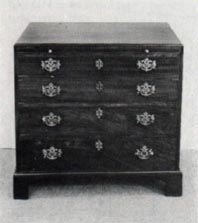 The period from which the “best” out of period pieces come from is
approximately 1830-60. They are therefore antiques in their own right and will show considerable ageing. Several factors conspire to make this period the best of
reproduction, especially of George II and George III fine mahogany furniture. First, the craftsmanship at that time was at its highest level. Secondly, the advent of
mechanisation meant that some pieces could be reproduced cheaply in multiples. And third, “antique” furniture was beginning to be appreciated in its own right. The period from which the “best” out of period pieces come from is
approximately 1830-60. They are therefore antiques in their own right and will show considerable ageing. Several factors conspire to make this period the best of
reproduction, especially of George II and George III fine mahogany furniture. First, the craftsmanship at that time was at its highest level. Secondly, the advent of
mechanisation meant that some pieces could be reproduced cheaply in multiples. And third, “antique” furniture was beginning to be appreciated in its own right.
During the latter part of the 19th Century, and during the Edwardian period of the 20th, a different kind of reproduction became commonplace. There was a
revival of most of the late 18th Century styles: Chippendale, Adam, Hepplewhite, and Sheraton. The resulting furniture was less than a reproduction than pieces which were
made in that sort of style. This sort of reproduction is easy to spot and can usually be taken at face value.
Copyright 2001 Pattaya Mail Publishing Co.Ltd.
370/7-8 Pattaya Second Road, Pattaya City, Chonburi 20260, Thailand
Tel.66-38 411 240-1, 413 240-1, Fax:66-38 427 596; e-mail: [email protected]
|

Skal
International
|
 Prince Henrik: a portrait. Photo by
Peter Cummins
Prince Henrik: a portrait. Photo by
Peter Cummins Queen Margrethe II of Denmark:
portrait of a Monarch. Photo by Jan Olav Aamlid
Queen Margrethe II of Denmark:
portrait of a Monarch. Photo by Jan Olav Aamlid HRH Princess Maha Chakri Sirindhorn
admires one of Jan Olav’s exhibits at the National Museum. Photo by Jan Olav Aamlid
HRH Princess Maha Chakri Sirindhorn
admires one of Jan Olav’s exhibits at the National Museum. Photo by Jan Olav Aamlid Prince Henrik (L) with Phuket
King’s Cup Regatta principals (1989). Photo by Peter Cummins
Prince Henrik (L) with Phuket
King’s Cup Regatta principals (1989). Photo by Peter Cummins The Sailing Prince drives Viking
Virtue to windward. Photo by Peter Cummins
The Sailing Prince drives Viking
Virtue to windward. Photo by Peter Cummins At the helm: a temporary release
from regal obligations. Photo by Peter Cummins
At the helm: a temporary release
from regal obligations. Photo by Peter Cummins Gracing the opening of the Third
Regatta (L to R): Former PM Prem, Regatta president Peter Ole Herning, Regatta founder Mom Tri Devakul, Prince Henrik and Regatta manager Khun Pornchai. Photo by Peter Cummins
Gracing the opening of the Third
Regatta (L to R): Former PM Prem, Regatta president Peter Ole Herning, Regatta founder Mom Tri Devakul, Prince Henrik and Regatta manager Khun Pornchai. Photo by Peter Cummins Prince Henrik greets the scribe
and his aide, Jakob Johannsen. Photo by Annie
Prince Henrik greets the scribe
and his aide, Jakob Johannsen. Photo by Annie The scribe interviews the Prince.
Photo by Annie
The scribe interviews the Prince.
Photo by Annie The Pattaya Mail scribe
interviews the Prince. Photo by Annie
The Pattaya Mail scribe
interviews the Prince. Photo by Annie Father Raymond Brennan cheerfully
and with much gratitude accepts a 500,000 baht donation from Julie Garrat, president of the Pattaya International Ladies Club on behalf of the PILC.
Father Raymond Brennan cheerfully
and with much gratitude accepts a 500,000 baht donation from Julie Garrat, president of the Pattaya International Ladies Club on behalf of the PILC. launch party was held at Boyz Boyz Boyz club and raised
130,000 baht for the PGF charities. 100,000 baht was raised through entrance and raffle ticket sales and a collection box for donations. An additional 30,000 baht was donated
by Boyz Boyz Boyz.
launch party was held at Boyz Boyz Boyz club and raised
130,000 baht for the PGF charities. 100,000 baht was raised through entrance and raffle ticket sales and a collection box for donations. An additional 30,000 baht was donated
by Boyz Boyz Boyz. The Better Band wowed the crowd at
Shenanigans last week
The Better Band wowed the crowd at
Shenanigans last week Softball chairman John McAllen, on
behalf of Pattaya Sports Club, presented school supplies to Pattaya School No. 7.
Softball chairman John McAllen, on
behalf of Pattaya Sports Club, presented school supplies to Pattaya School No. 7. Khomsan was selected for sacrifices made on the job, his personal endurance, honesty,
and persevering when facing difficult situations.
Khomsan was selected for sacrifices made on the job, his personal endurance, honesty,
and persevering when facing difficult situations. By Ranjith Chandrasiri
By Ranjith Chandrasiri Pastiches
Pastiches The period from which the “best” out of period pieces come from is
approximately 1830-60. They are therefore antiques in their own right and will show considerable ageing. Several factors conspire to make this period the best of
reproduction, especially of George II and George III fine mahogany furniture. First, the craftsmanship at that time was at its highest level. Secondly, the advent of
mechanisation meant that some pieces could be reproduced cheaply in multiples. And third, “antique” furniture was beginning to be appreciated in its own right.
The period from which the “best” out of period pieces come from is
approximately 1830-60. They are therefore antiques in their own right and will show considerable ageing. Several factors conspire to make this period the best of
reproduction, especially of George II and George III fine mahogany furniture. First, the craftsmanship at that time was at its highest level. Secondly, the advent of
mechanisation meant that some pieces could be reproduced cheaply in multiples. And third, “antique” furniture was beginning to be appreciated in its own right.